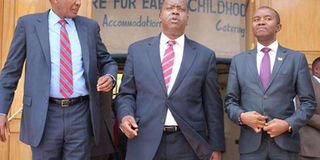Boys outshine girls in maths, science

From left, Cabinet Secretaries Joseph Nkaissery (Interior), Fred Matiang'i (Education) and Joe Mucheru (ICT) during the release of the KCPE results at the Kenya Institute of Curriculum Development on December 1, 2016. PHOTO | DENNIS ONSONGO | NATION MEDIA GROUP
What you need to know:
- Bungoma had 109 physically or mentally challenged candidates, while Kiambu had 41 and Nairobi 39.
- Dr Matiang’i said 23 counties registered more girls than boys in the examination.
Education Cabinet Secretary Fred Matiang’i said the overall KCPE performance was lower than last year’s.
The number of candidates with more than 400 marks decreased by 31 per cent to 5,190, compared with 7,560 last year, while the top candidate scored 437 marks out of the maximum possible 500 marks.
Girls performed better than boys in languages — English, Kiswahili and Kenya Sign Language — in the Standard Eight examination results released Thursday.
Boys were, however, better in mathematics, science and social studies and religion.
Out of the 942,021 candidates 49.7 per cent were girls and 50.3 per cent boys.
“This gender composition has comparatively remained the same over the last three years,” said Dr Matiang’i.
The analysis by gender in the last three years indicates that the percentage increase in the number of girls has consistently been higher than that of boys.
Dr Matiang’i said 23 counties registered more girls than boys in the examination.
These are Mombasa, Nyandarua, Kiambu, Machakos, Kitui, Embu, Meru, Makueni, Nairobi, Trans Nzoia, Uasin Gishu, Nakuru and Kericho.
Others are Nandi, Elgeyo-Marakwet, Busia, Bungoma, Kakamega, Vihiga, Kisii and Kisumu and Nyamira.
This year, 1,950 candidates with special needs sat the examination, with the best scoring 421 marks.
The candidates were given 45 minutes instead of the standard 30 for each of the papers.
“The ministry is determined to continue doing all it takes to ensure that special-needs children access quality education,” said Dr Matiang’i.
Kiambu had the highest number of blind candidates at 21, with Kilifi, Kericho, Baringo, Bungoma and Kisii having one each. Last year, Kiambu had 23 blind candidates.
Kisumu had the highest number of those with impaired vision at 42, followed by Homa Bay at 31, Nairobi at 28 and Kakamega at 21.
Last year, West Pokot had 41, Kisumu 40, Bungoma 39, Homa Bay 37, Siaya 31 and Kisii 4.
Bungoma had 109 physically or mentally challenged candidates, while Kiambu had 41 and Nairobi 39.
Bungoma had the highest number of special-needs candidates at 170.





